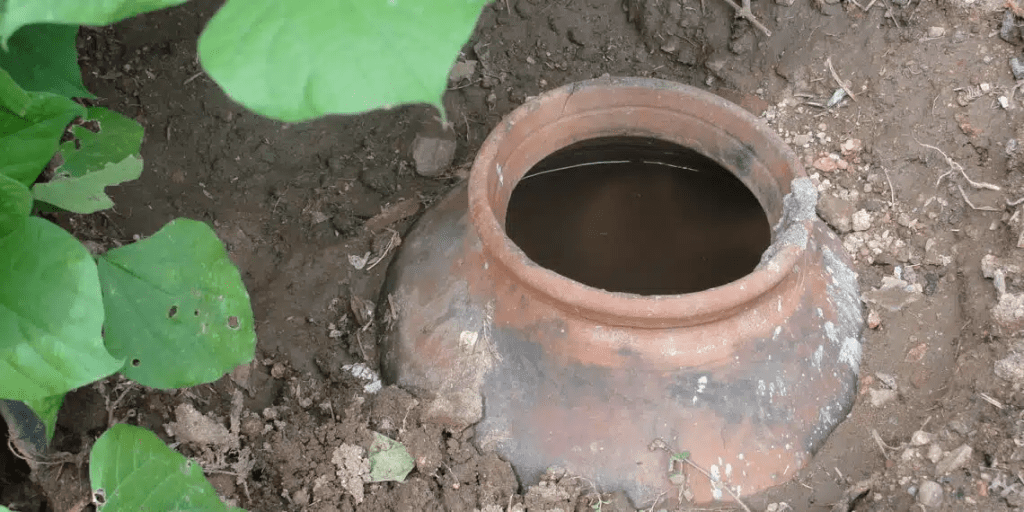
In a world where water conservation is becoming increasingly critical, gardeners are seeking innovative ways to maintain thriving gardens while minimizing water usage.
One ancient yet highly effective technique gaining popularity is the use of buried terracotta pots, also known as “ollas.”
This simple, eco-friendly method allows you to garden with less water while promoting healthy plant growth.
Here’s a detailed look at how burying terracotta pots can transform your gardening practices and help you save water.
What Are Terracotta Pots (Ollas)?
Terracotta pots, made from porous clay, have been used for centuries as a natural irrigation system.
When buried in the soil and filled with water, these pots slowly release moisture through their porous walls, delivering water directly to plant roots where it’s needed most.
- Key Features of Ollas:
- Made from unglazed terracotta clay.
- Typically round with a narrow neck and wide belly.
- Designed to hold and gradually release water into the surrounding soil.
This method is highly efficient and is particularly beneficial in arid regions or during dry seasons.
How Burying Terracotta Pots Saves Water
The primary advantage of using buried terracotta pots is their ability to reduce water waste. Here’s how it works:
- Targeted Irrigation:
- Water seeps through the porous walls of the pot directly to the surrounding soil, ensuring it reaches plant roots without runoff or evaporation.
- Reduced Evaporation:
- Unlike surface watering, where much of the water evaporates before reaching the roots, the olla’s underground placement minimizes water loss.
- Prevents Overwatering:
- Plants absorb only the water they need, preventing waterlogging and promoting healthy root systems.
- Saves Time:
- A single filling of the pot can last several days, depending on the soil and plant needs, reducing the frequency of watering.
Benefits of Using Buried Terracotta Pots
- Water Conservation:
- Saves up to 50-70% of water compared to traditional irrigation methods.
- Promotes Healthy Plants:
- Provides consistent moisture to plants, preventing stress caused by over- or under-watering.
- Improves Soil Health:
- Encourages deep root growth and enhances soil structure.
- Eco-Friendly:
- Reduces reliance on external irrigation systems and minimizes water waste.
- Cost-Effective:
- Once installed, ollas require minimal maintenance and reduce water bills over time.
- Adaptable to Various Garden Types:
- Ideal for vegetable gardens, flower beds, raised beds, and even potted plants.
How to Use Buried Terracotta Pots in Your Garden
Step 1: Choose the Right Pots
- Select unglazed terracotta pots or purchase specially designed ollas.
- The size of the pot depends on the size of your garden. Larger pots work well for bigger beds, while smaller ones are ideal for compact spaces.
Step 2: Prepare the Soil
- Loosen the soil where you plan to bury the pots. Ensure the area is free from rocks and debris that could damage the pots.
Step 3: Bury the Pots
- Dig a hole deep enough to bury the pot up to its neck.
- Place the pot in the hole, ensuring the neck is level with or slightly above the soil surface.
- Fill the area around the pot with soil, pressing firmly to secure it in place.
Step 4: Fill with Water
- Pour water into the pot until it’s full.
- Cover the opening with a lid or a flat stone to prevent debris and evaporation.
Step 5: Plant Around the Pot
- Arrange your plants around the buried pot. Place them close enough to benefit from the water but not so close that their roots could damage the pot.
Step 6: Monitor and Refill
- Check the water level every few days, refilling as needed. Frequency depends on the climate, soil type, and plant water requirements.
Plants That Thrive with Terracotta Pot Irrigation
Many plants benefit from the consistent moisture provided by ollas. Some great options include:
- Vegetables:
- Tomatoes, peppers, cucumbers, squash, and beans.
- Herbs:
- Basil, parsley, cilantro, and thyme.
- Flowers:
- Marigolds, petunias, and zinnias.
- Fruit Plants:
- Strawberries, melons, and citrus trees.
Tips for Maximizing Efficiency
- Group Plants Wisely:
- Plant crops with similar water needs around the same olla to ensure efficient watering.
- Use Mulch:
- Add a layer of mulch around the pot and plants to further reduce evaporation and retain soil moisture.
- Regular Maintenance:
- Check for cracks in the pots and ensure the water is free from contaminants.
- Combine with Other Methods:
- Use ollas alongside drip irrigation or rainwater harvesting for maximum water efficiency.
Why Terracotta Pots Are a Sustainable Gardening Solution
- Reduces Carbon Footprint:
- By conserving water and minimizing the need for synthetic irrigation systems, ollas contribute to sustainable gardening practices.
- Repurposes Materials:
- Broken or unused terracotta pots can be recycled into ollas, reducing waste.
- Encourages Biodiversity:
- Consistent soil moisture supports a healthy ecosystem, attracting beneficial insects and microorganisms.
Common Questions About Burying Terracotta Pots
- Can I use glazed terracotta pots?
- No, glazed pots are not porous and won’t allow water to seep through.
- How deep should I bury the pots?
- Bury the pots up to their neck, leaving the opening accessible for refilling.
- Can I use ollas in sandy soil?
- Yes, but you may need to refill them more frequently as sandy soil drains quickly.
- Do terracotta pots work in cold climates?
- They can crack in freezing temperatures. Remove and store them during winter or use them in raised beds with proper insulation.
Burying terracotta pots is a time-tested technique that offers an efficient, eco-friendly way to garden with less water.
Whether you’re growing vegetables, herbs, or flowers, this method ensures your plants receive consistent moisture while conserving water.
With minimal effort and cost, you can transform your garden into a thriving oasis that aligns with sustainable gardening practices.
Start incorporating buried terracotta pots into your gardening routine today and experience the benefits of water-wise gardening firsthand!


